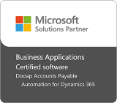
We all know accounts payable can be a cumbersome, time-intensive process when done on paper or through ill-designed software, not to mention prone to human error, lost invoices, delayed actions, and ultimately late payments resulting in more expenses for the company.
But it doesn’t have to be this way.
AP automation can be dramatically enhanced and simplified with a focus on the user experience. When software is designed with the user in mind, it can cut down on the potential for error, speed up tasks, and ultimately make the job more enjoyable. With well-designed software function and interface, AP professionals can feel better supported and more motivated in their work.
It really comes down to designing for both the professional using the software every day and the invoice reviewers and approvers, who need a quick and easy way to understand and approve payments without interrupting their workflow.
Overcome AP Pain Points with User-Friendly AP Automation Software
If you are among the growing number of accounting professionals handling AP for your clients, you know that in order to be truly efficient, you need to sort multiple invoices at one time, access and use old invoices as a template, check for duplicates, and perform an array of other actions quickly and seamlessly. It’s an expensive process, with each manually handled invoice costing in the tens of dollars. AP Automation brings many benefits, including the opportunity for AP personnel to focus on value-adding work instead of mindless routines.
So, how can we automate the monotonous details, help personnel understand information and invoices seamlessly, and provide true value-add to the AP process? The answer is efficient and user-friendly software.
Ideally, AP software should be designed by people with experience in AP work. It should come from AP professionals (like accountants or CPAs) for AP professionals. Here are some examples of routine pain points that only AP experience can help to make a better software solution:
Invoice history. Users must be able to check the invoicing history data seamlessly to avoid doubling up on invoices or inserting the same lines – of code, workflows, etc. – over and over again. This limits the amount of monotonous work and time that an AP professional must spend on these tasks and prevents human error, eliminating issues like double invoices that have already been paid or perhaps accidentally sent twice.
Machine learning and analytics. A great AP software should be capable of “learning” what prevents users from being most efficient. If unnecessary routines that could be automated occur repeatedly, software should be able to analyze this and suggest new best practices.
User interface. The way a software looks can drastically impact the quality and speed of work that AP professionals are able to do. Being able to see key information easily, minimizing the necessity of typing, and offering efficient keyboard shortcuts are all factors that can improve the process.
Easy Invoice Approvals
In some cases, it’s necessary for personnel outside of the AP department to approve or review an invoice. Often, learning to approve and review invoices requires training the employee on the software system and, even after training, still takes a large portion of the person’s time to go through the approval process. With a well-designed user-friendly interface, reviewing and approving an invoice can be the simplest task an employee does, ensuring these tasks are done in a timely manner.
Mobile Optimized Invoice Interface
The way we work has changed drastically. Mobile is at the center of the user experience. We work from many different locations and across many different devices. With this in mind, approving invoices should not be tied to desktop work.
A good mobile app paired with desktop functionality makes it easier to run a bulk of invoices through the workflow and on to payment fulfillment, ensuring that late payments aren’t incurred and that dynamic discounts can be utilized to their full potential.
A good mobile app forces users to get things done and prevents invoice pileup.
Taking the Next Steps Toward AP Automation
It’s clear that the accounts payable space has not kept pace with the modern user, and it’s time to change that. AP shouldn’t be dreaded work that is ultimately seen as inefficient and cost-heavy. It should be automated, interesting, and rewarding. We can make it that way through well-designed, secure software.
A great user experience builds trust and collaboration between people. It is not just computed data pushed in front of you on a gray piece of paper; it’s about how the data is shared from one person to another.
Moreover, it motivates people. It empowers people. It improves automation and data accuracy. It brings value to the human input.
You can complete your AP toolset with AP automation. Download the Road to AP Automation Guidebook series to learn more about next steps.
This blog text appeared first at AccountingWEB on Jun 24th 2016








